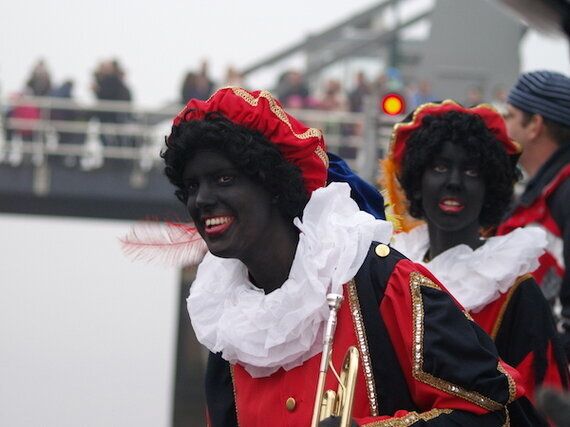
Do you remember golliwogs? Those black rag dolls with frizzy hair and red lips? You probably do, although most golliwog toys and references have succumbed to a UK-wide extermination process in the last few decades. Well, the toy hasn't exactly done much to promote racial equality and tolerance: terms like 'golliwog' and 'wog' entered the slang lexicon as racial slurs.
Such cultural mishaps may help explain why the British public reacts with widespread outrage at 'culturally insensitive' behaviour, such as students dressing up in Somali pirate costumes at the University of Edinburgh (black face paint included). But what the British public may not realise is that every year on December 5th and 6th, only 150 miles away by sea, a whole nation watches as thousands of Dutch people cover their faces with black paint, colour their lips a furious red while donning jester-like robes, Afro-style wigs and golden hoop earrings. In the Netherlands, it's considered tradition.
Zwarte Piet, or Black Pete, is a figure firmly established in Dutch and Belgian folklore, first appearing in records from the 1850s. He does pretty much what Santa's elves do: helps the Dutch Sinterklaas deliver gifts to children. But he's not your innocent little elf.
The Zwarte Piet phenomenon sparks heated debate annually, though it has grown in force and significance over the last few years. The tradition's opponents view Zwarte Piet as a caricature of black people or, worse, black slaves. He is, after all, the white Sinterklaas' servant. For a long time, Zwarte Piet gave out punishments to naughty children, while Sinterklaas rewarded the good ones - a Flemish friend described her childhood fear of black people as directly related to Zwarte Piet's mean character.
It's true that the he has undergone a major makeover and is nowadays perceived to be the kind mascot that every Dutch or Belgian child cheerfully welcomes come December. But many adults aren't convinced, still holding the opinion that Zwarte Piet should be wiped out from Holland's cultural heritage. A number of protests, official complains and media actions targeted the tradition this year, criticising it as anachronistic and offensive.
In fact, 2013 has been the year of the widest Piet controversy so far. Just last month, a request to grant Sinterklaas a place on the UNESCO Intangible cultural heritage list was rejected - primarily because of the figure of Zwarte Piet. Around the same time, the Dutch government received a document from the UN's high commission on human rights stating that the Zwarte Piet practice 'may infringe upon human rights.' The document later turned out to be a hoax, sent in by an overzealous consultant who had not been authorised to act on behalf of the UN in this matter.
Still, Zwarte Piet enjoys immense popularity across Holland. A Facebook group was launched last month in support of Piet. With a million likes collected in a single day, it now boasts well over 2 million supporters including two of my very own Facebook friends. Not bad for a country of 17 million. A survey conducted this October found that 96% of the Dutch population share this mindset. In the former Dutch colonies of Bonaire and Curaçao, all members of the public, black and white alike, join in the celebration of Sinterklaas' arrival.
So what is the right answer?
A Dutch person is likely to tell you that Zwarte Piet is in no way a racist symbol and is not meant to promote destructive stereotypes. That he is not a reference to Holland's colonial history or the white man's centuries-long domination over other races. In a nutshell, that it's just tradition. Many will defend their non-racist stance by insisting that Zwarte Piet isn't actually black: he's just climbed down so many chimneys while delivering gifts that he's covered in black soot.
But if he's just been blackened by the soot, why are his clothes so sparkling clean?
There are several compelling reasons why Zwarte Piet should get the chop. In a country where right-wing populist politicians like Geert Wilders are garnering voter support, Zwarte Piet may become to the Netherlands what the golliwog had become to the UK: a racial slur reminding an entire nation of ethnic struggle and racial prejudice.
A Belgian friend of mine recently told me a story. A few years ago, she invited her then-boyfriend, a black Frenchman, to meet her family. Much to their consternation, an all too-animated uncle referred to the boyfriend as Zwarte Piet. He meant it as a joke, but was left the only one laughing.